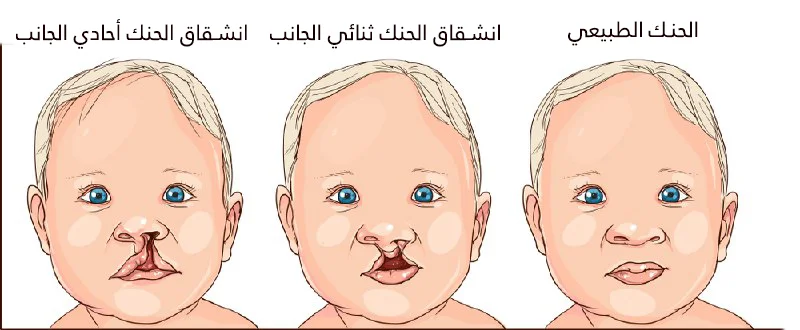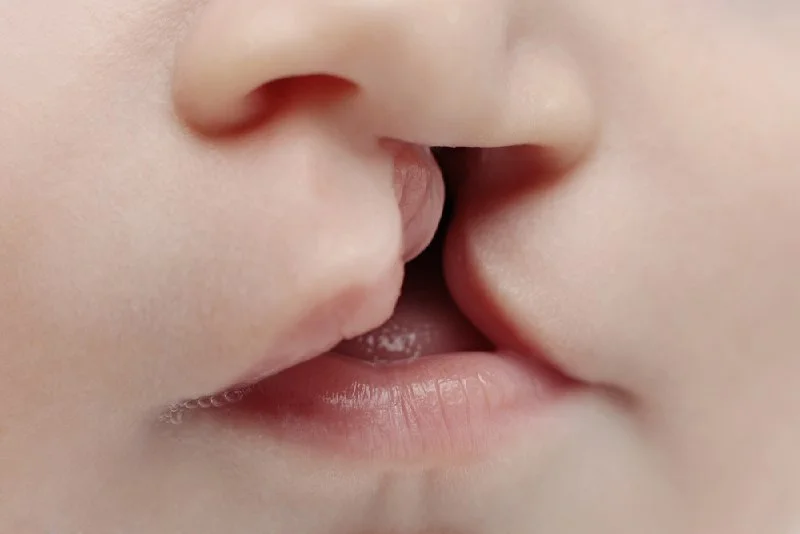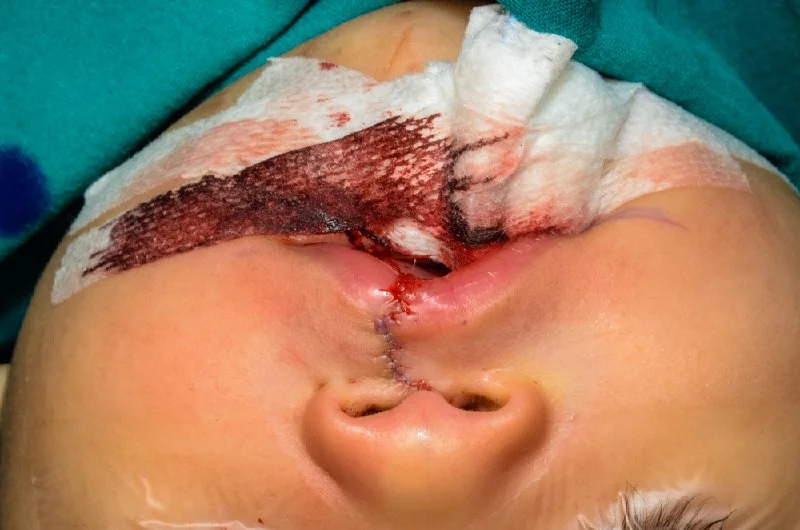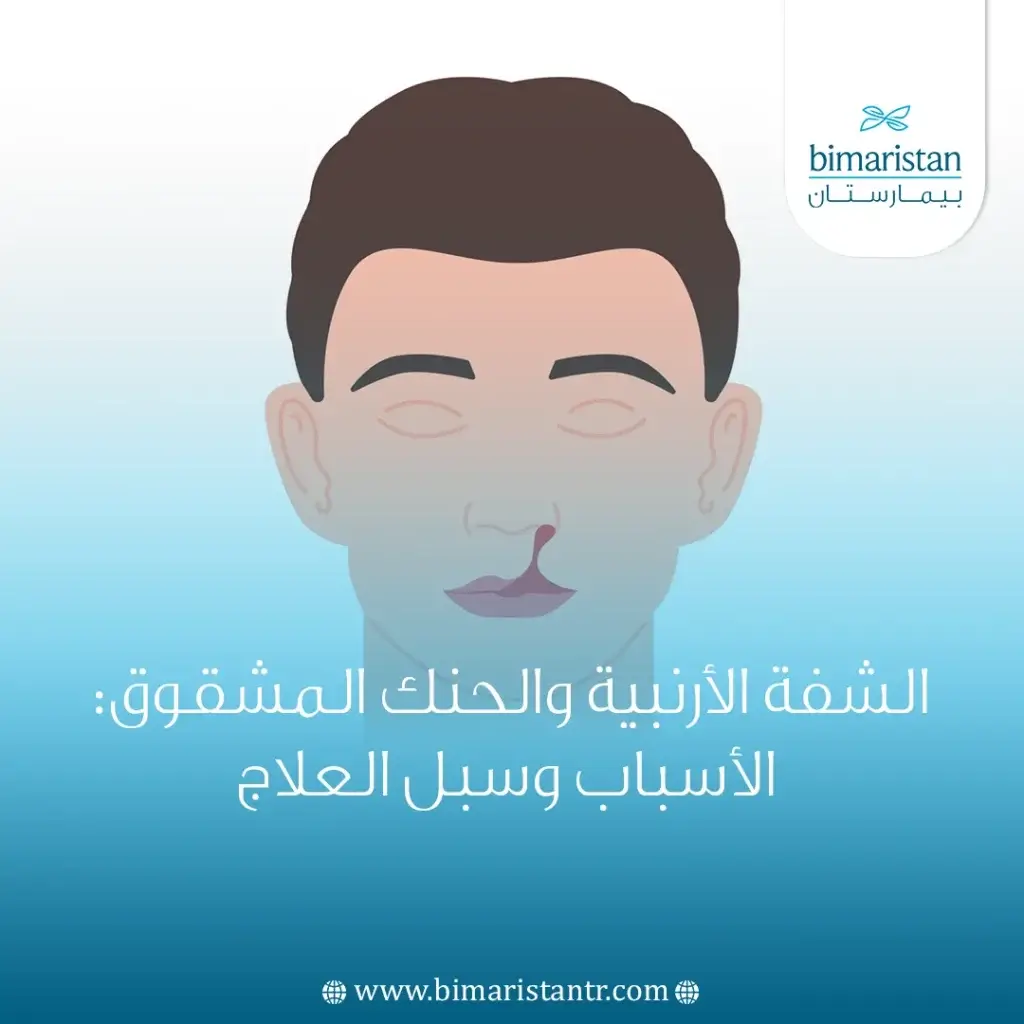الأمر الذي يتطلب علاجًًا جراحيًا مستعجلًا في معظم الحالات ويشترك عدد من الأسباب في حدوثها، ما هي الأسباب وسبل العلاج الجراحية المتاحة لتصحيح شق الشفة والحنك في تركيا وأكثر في هذا المقال.
يولد بعض الأطفال بعيوب خلقية في الفم والشفتين من أشهر هذه العيوب الشفة الأرنبية أو ما يسمى أيضًا بالشفه المشقوقة (cleft lip) والتي قد تكون مصحوبة بشق في سقف الفك (cleft palate) وليس الشفة فحسب.
وهذا ما يطلق عليه الشقوق الوجهية الفموية وتظهر منذ الولادة.
لكن من الجيد أنه يمكن إصلاح هذه التشوهات واغلاق فجوات الفك المشقوق وشق الشفة العلوية.
يمكن تصحيح عيب الشفة الأرنبية و الحنك العلوي المشقوق من خلال القيام بسلسة من الجراحات بهدف استعادة الوظيفة والشكل الطبيعي للفم ومحاولة استعادة الملامح المعتادة بأقل نسبة من الآثار.
ما هو المقصود بالشفاه الأرنبية المشقوقة؟
عدم حدوث هذا الاندماج يتسبب في خلل خلقي يطلق عليه مسمى الشفة الأرنبية (cleft lip). قد تكون الشفة المشقوقة صغيرة وقد تكون كبيرة وتمتد للأنف.
بينما يتطور الحلق أو ما يعرف بالحنق في الفترة ما بين الأسبوع السادس للتاسع للحمل ويحدث الحنك المشقوق (cleft palate) للسبب نفسه وهو فشل حدوث اندماج انسجة الحلق في سقف الفم ما بين الجهتين االيمين واليسار وقد يكون هذا الشق في الجزء الأمامي أو الخلفي أو كليهما.

- انشقاق في الشفة العليا في جهة واحدة أو في كلتا الجهتين وتكون شكل الشفة أشبه بفم الارنب.
- امتداد الشق من أعلى الشفة إلى اللثة وأعلى الحنك وقد يصل الأمر إلى أسفل الأنف ليصبح كلًا من تجويف الانف والفم مفتوحين على بعضهما.
- أن يكون سقف الحنك مشقوقًا ولكن دون أي عيوب خلقيه ظاهرية.
- في حالات قليلة قد تكون الفتحة في النسيج الرخو من الحنك أي في الجهة الخلفية المبطنة لتجويف الفم الداخلي.
وهذه الحالة لا يتم اكتشافها وتشخيصها إلا عندما تبدأ الأعراض الأخرى.
ما هي أعراض الشفة الأرنبية والحنك المشقوق؟
بالإضافة لكون مظهرهم غير طبيعي فإن الفتحات في الشفة العليا والحنك تتسبب فيما يلي:
- صعوبة في الرضاعة الطبيعية وتناول الغذاء في سن أكبر.
- العدوى والتهابات الأذن والأنف المتكررة.
- انغلاق الأذن بالشمع نتيجة التهابها المتكرر مما يؤثر على تطور السمع.
- عدم نمو الأسنان بالشكل الصحيح بالإضافة لكونهم أكثر عرضة للجير وانحراف الاسنان.
- صعوبة في نطق الكلمات بالإضافة إلى صوت الحديث الأنفي عندما يصبح الطفل أكبر.
ما هي أسباب الشفة الأرنبية والحنك المشقوق؟
يحدث شق الفم والحنك نتيجة فشل اندماج في أنسجة الوجه المركزية بشكل جزئي أو كلي في الحلق أو الشفاه وهذا يؤدي إلى فتحة فيها.
السبب في الشفة المشقوقة وشق الحنق غير معروف ولا يوجد سبب واضح له حتى وقتنا الحالي.
يعتقد العديد من الأطباء أن هناك عوامل عدة تشترك في ولادة السيدات لأجنة مصابين بالشفة الأرنبية والحنك المشقوق.

حيث يعتقد أن بعض الممارسات التي تقوم بها السيدة الحامل قد تنشط جينات معينة تؤدي بدورها فشل اتحاد الرابطة المركزية في حنك الجنين وشفته.
ربما قد تكون الوراثة مستقلة ولا تتضمن أي أعراض لمتلازمة أخرى وقد تكون ضمن مزيج من المشكلات الوراثية.
لابد من تحفيز هذه الجينات الموجودة بالظروف البيئية المختلفة والتي تسمى بعوامل الخطر.
عوامل الخطر المؤدية لشق بالحنك والشفة
- تعرض السيدة الحامل لمواد ضارة كالسجائر والكحول والأدوية.
حيث تزداد فرصة حصول شقوق الشفة والحنك عند السيدات المدخنات واللواتي يشربن الكحول. - الوراثة العائلية، فوجود تاريخ عائلي للشفة الأرنبية والحنك المشقوق عند الوالدين سواء في أسرة الأب أو الام يزيد من احتمالية نقل جين الحنك المشقوق للطفل.
- الإصابة بالسكري المزمن أو ملاحظة كون الحامل تعاني من السكري قبل حملها تزيد من فرصة حدوث تشوهات لدى الاجنة.
حيث أن السيدة المصابة بسكري الدم معرضة لولادة جنين يعاني من الشفة الأرنبية والحنك المشقوق بنسبة أكبر من غيرهن. - السيدات المشخصة بالصرع أو الاكتئاب وتستخدم أدويتهم بصورة مستمر حيث أن بعض هذه الأدوية لابد من التوقف عن أخذها لأنه قد تسبب تشوهات إذا تم تعاطيها خلال الشهور الثلاثة الأولى من الحمل.
- السيدات اللواتي يعانون من السمنة المفرطة.
وجد أن هناك ارتباط بين ولادة أطفال بعيب خلقي مثل الشفة المشقوقة العليا وسقف الحلق المشقوق وكون الامهات لديهن سمنة خطيرة.
كما أن الشفة الأرنبية سواء مع الحنك المشقوق أو من دونها تزيد نسبتها عند الإصابة ببعض المتلازمات مثل متلازمة دي جورج (حذف 22q11).
كيف يمكن الوقاية من الشفة الأرنبية والحنك المشقوق؟
لا يمكن نفي احتمالية تكرر عيب الفم والحلق في وقت لاحق ولكن نسبة حصول ذلك منخفضة وتتراوح ما بين 2 إلى 8%.
- إذا كنتي تعتقدين أنك حامل أو تخططين للحمل في الفترة المقبلة فمن الأفضل طلب الاستشارة الطبية.
يساعدك إجراء الفحص الوراثي وفحص السكر وكتلة الجسم من تجنب عوامل الخطر المختلفة ومحاولة ضبطها. - إذا كنتي مصابة بالصرع يجب عليك تنظيم أدويتك وطلب تغييرها لأدوية أقل خطرًا على الجنين.
هذا ليس مهم ويحمي من الإصابة بالشفة الأرنبية والحنك المشقوق فحسب بل يقلل فرصة حدوث الكثير من التشوهات الخلقية. - يجب عليك أخذ الفيتامينات الضرورية قبل وأثناء فترة حملك.
حمض الفوليك يعتبر أساسي ومهم للحماية من تشوهات الوجه والعمود الفقري. - التوقف عن التدخين وشرب الكحول.
كيف يمكن تشخيص الشفة المشقوقة وشق الحلق ؟
يكون شكل الشفة العليا أشبه بالثلمة أو شفاه الارنب المشقوقة كما قد يصاحبها فتحات في الحنك.
يساعد تصوير الأجنة في الرحم بالالتراساوند على تشخيصهم بتشوهات داخل الرحم ولا يحتاج الأمر القيام بأية فحوصات خاصة.
حيث يلاحظ الطبيب أن هناك خلل وعدم تكافؤ ما بين نصفي الشفة العلويه.
من السهل معرفة وتشخيص الشفة الأرنبية عبر الفحص بالموجات فوق الصوتية ولكن الحنك المشقوق قد يتأخر تشخيصه لفترات أبعد ومن الصعب رؤيته لاسيما إذا كان في الجزء الداخلي من الحنك.
كما قد يقترح عليك فحص جيني إذا كان لديك رغبة بالحمل في مرات قادمة.
ثم يعرض الطفل على طبيب مختص من أجل معرفة سبل علاج شق الشفة والحنك المتاحة والإجابة على تساؤلات الوالدين.
علاج الشفة الأرنبية والحنك المشقوق في تركيا
- أطباء الأنف والأذن والحنجرة.
- جراحين الوجه و الفم.
- المختصين بتقويم انحراف الأسنان لمعالجة مشاكل الفك والأسنان المصاحبة لـ انشقاقات الشفة والحنك.
- جراحة الأطفال.
- معالجين النطق والسمع.
- خبراء علم الوراثة.
- اخصائيين نفسيين واجتماعيين.
جراحة الشفة الأرنبية والحنك المشقوق في تركيا
كما يختلف العمر المناسب لعملية الشفة الأرنبية، فبعضهم يحتاجون لجراحة سريعة والبعض قد ينتظرون حتى بلوغ عمر 18 شهر.
التصحيح الجراحي ضروري لتعديل شكل الوجه كما أنه يحسن من التنفس والتغذية والسمع وغيرها من الوظائف الأساسية.

- إغلاق الشفة المشقوقة خلال الشهور الستة الأولى.
- تصويب شق الحنك في مدى أقصاها 12 شهر ويفضل اجراؤه بأقرب وقت.
- عمليات جراحية لاحقة حسب حاجة الطفل أثناء نموه وحتى البلوغ.
التعامل مع مضاعفات الشفة المشقوقة
- استخدام زجاجة خاصة للرضاعة مع مراعاة تقليل كمية الحليب كي لا يتعب طفلك أثناء الرضاعة.
- الالتحاق ببرامج معالجة النطق.
- المتابعة الدورية لدى طبيب الاسنان ووضع التقويم في الوقت المناسب واستشارته حول المحافظة على صحة الفم والأسنان.
- علاج التهابات الأذن والانتباه لمضاعفاتها.
- طلب استشارة أخصائي السمع حول حاجة الطفل لأجهزة مساعدة للسمع.
- الدمج المجتمعي ودعم الأهل والأطفال لمساعدتهم على تقبل مظهرهم ودعمهم نفسيًا.
